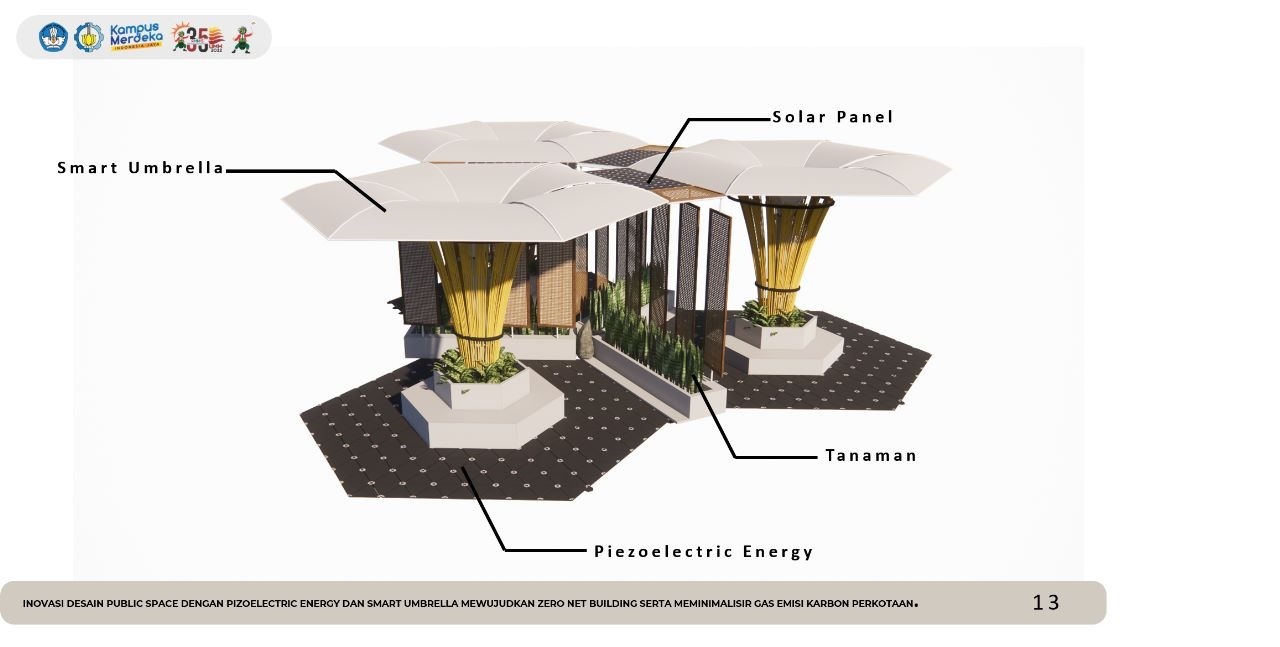ITS Students Initiate Design of Environmentally Friendly Public Spaces in Cities

The appearance of futuristic and environmentally friendly public space designs in urban areas was the idea of a team of ITS students
ITS Campus, ITS News — Energy consumption in large public spaces causes many problems, including increased operational costs and carbon emissions. Responding to this problem, a team of students from Institut Teknologi Spuluh Nopember (ITS) initiated a futuristic and environmentally friendly public space design.
An increase in the number of public spaces in urban areas has an impact on increasing energy use, operational costs, and carbon emissions. This can occur due to the design of public spaces that are not environmentally friendly, so that a lot of energy is wasted. Examples include the use of electricity and water.
Departing from these problems, the student team chaired by Ailsashofa Alfadhila initiated a futuristic and environmentally friendly public space design that can produce clean energy independently. The design applies appropriate Piezoelectric Energy and Smart Umbrella technologies. “Piezoelectric Energy will be installed on the floor, while the Smart Umbrella will be built on top of it,” explained the girl who is usually called Ailsa.

The design of public spaces was the idea of a team of ITS students who applied Piezoelectric Energy and Smart Umbrella technology
The class of 2019 student said that Piezoelectric Energy has the principle of kinetic energy pressure in the form of human footing when walking or running. The pressure exerted on the floor is then converted into electricity. The Smart Umbrella Design is also designed with solar panels to convert sunlight into electricity.
Furthermore, this student who was born in 2001 said that all the electricity generated will be used for the operation of public spaces. Among them are for open space lighting, mobile battery charging stations, to road signs. In addition, the concave design of the umbrella can function as a rain-fed device for watering plants.
The types of plants planted are also plants that can absorb carbon emissions. “That is the mother-in-law’s tongue plant which can absorb 46.7 percent of pollutant gas and lilies as much as 25 percent of carbon dioxide gas,” he explained.
With various applications of existing technology, this unique and futuristic design has the potential to attract the attention of urban communities to gather in public spaces. This interaction has the potential to revive the value of socio-cultural sustainability which is increasingly being eroded in urban areas. In addition, the community can play a direct role in producing clean energy.

The ITS PKM VGK team consisting of Ailsashofa Alfadhila, Retno Dewi Handayani, Fauziyah Nurul Afa, Azkia Laila Azra, and Izaaz Abdul Harits won a bronze medal at the 2022 Pimnas
Through this innovation, the ITS Student Creativity Program (PKM) team in the Constructive Idea Video (VGK) category won a bronze medal in the 2022 National Student Scientific Week (Pimnas). Besides Ailsa, this team is also fronted by Retno Dewi Handayani, Fauziyah Nurul Afa, Azkia Laila Azra, and Izaaz Abdul Harits. Ailsa hopes that her team’s innovation can shape the city of the future, where the community can play an active role in realizing environmental sustainability. “Not only as a consumer, but also as a producer of clean energy,” he said hopefully. (ITS Public Relations)
Reporter: Nurul Lathifah
Related News
-
ITS Wins 2024 Project Implementation Award for Commitment to Gender Implementation
ITS Campus, ITS News —Not only technology-oriented, Institut Teknologi Sepuluh Nopember (ITS) also show its commitment to support gender
February 09, 2023 19:02 -
ITS Professor Researched the Role of Human Integration in Sustainable Architecture
ITS Campus, ITS News –The developing era has an impact on many aspects of life, including in the field
February 09, 2023 19:02 -
ITS Sends Off Group for Joint Homecoming to 64 Destination Areas
ITS Campus, ITS News — Approaching Eid al-Fitr, the Sepuluh Nopember Institute of Technology (ITS) is once again facilitating academics who want
February 09, 2023 19:02 -
ITS Expert: IHSG Decline Has Significant Impact on Indonesian Economy
ITS Campus, ITS News — The decline in the Composite Stock Price Index (IHSG) by five percent on March 18,
February 09, 2023 19:02
